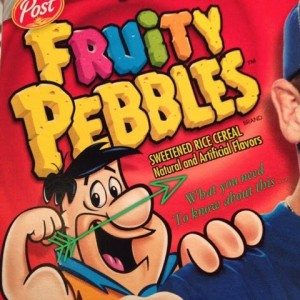We often hear the saying “eat the rainbow” referring to a variety of fresh colorful fruits and vegetables- and whenever possible organic is a bonus. However, what about the other rainbow of foods- you know, food dyes. Food dyes have been linked to an entire rainbow of risks from allergic reactions to hyperactivity in children.
Food dyes are used to make processed foods look more appealing- in fact, they are often dyed the same colors as that of their healthier counterparts. Considering how easily these dyes can be replaced with a healthier option such as ‘real fruit‘ and ‘real vegetable‘ juices- is it really wise to cut corners on our health and that of our kids just to save a few pennies?
I have always been aware of food dyes in our food but never actually witnessed a noticeable change in ones behavior- well, that was until my 3 (now, 4 year old) started acting out verbally and physically ironically after eating those chewy little treats kids love so much- you know those little things also known as fruit snacks. My kids eat pretty healthy most of the time and with all of their food sensitivities I never to be honest gave it a second thought. What’s the big deal- it’s just an occasional fruit snack.
Well, it was a big deal- a very big deal. He was out of control and verbally running his mouth in very unacceptable ways especially towards me. Who was this kid? This was not the same little boy that always hugs his momma and snuggles- this was clearly not my kid. It was as if I were reliving the gluten-free nightmare all over again- but how, he was already primarily on a gluten-free diet.
This time, my husband was the one that put the pieces together- Red 40. It was the dye- no sooner did we eliminate the problem and amazingly enough got our happy, loving boy back. He is still full of spunk but that is who he is- not the verbally belligerent child that we were witnessing after the consumption of artificial food dye.
According to the Center for Science in the Public Interest – Red 40 is among the most widely used of food dyes- it has been found to trigger hyperactivity in some children and cause allergy like reactions in others.
“Dyes are complex chemicals that were originally derived from coal tar, but now from petroleum.” Do you want to go eat some Fruit Loops now? Just kidding.
It is often said “we eat as much with our eyes as we do our stomachs” Companies like using dyes because they are cheaper and more vibrant than their natural counterparts.
How else can one cover the dull appearance of a bunch of basic processed ingredients?
Luckily, more consumers are demanding a change and making healthier more natural food choices in today’s markets- therefore causing companies to for-go such dyes or at a minimum change to natural safer alternatives- such as, beet juice, carrot juice, and paprika. (just an FYI paprika is in the nightshade family)
According to US Food and Drug Administration there has been a dramatic increase in food dyes since 1955 this being a fairly good representation of Americans increased processed food consumption over the years.
Unfortunately, the US has done very little in the way of taking a proactive stance against food dyes despite recent studies of consumer risks- therefore, you must take action yourself- here are
5 Reasons Your Family Should Avoid Artificial Food Dyes
Attention Deficit Disorder and Hyperactivity in children- According to the American Academy of Pediatrics (AAP) the consumption of artificial food dyes and children’s behavior has a definite link.
After a recent British study published in the Lancet the AAP concluded with the following editors note- “Dr.Schonwald writes; a recent meta-ananlysis of 15 trials concludes that there is ‘accumulating evidence that neurobehavioral toxicity’ may characterize a variety of widely distributed chemicals. Some children may be more sensitive to the effects of these chemicals”
Today, practitioners faced with hyperactive children have a reasonable alternative option to offer parents- a preservative-free, minimally processed, dye-free diet has been found to be both safe and effective for the child who is without other medical, psychological, and emotional issues. Working closely with a practitioner to find other known triggers is essential step in having an effective treatment plan. In 1994, researchers found that 73 percent of children with ADHD responded favorably to an elimination diet that includes eliminating all artificial colors as well.
Aggressive behavior. I have read countless testimony’s over the years of parents swearing by there child(ren’s) irate, irrational, uncontrollable, and often time unexplainable behaviors being caused by a suspected dye in take. Red #40 and Yellow #5 seem to be the biggest culprits.
At the time I never had any personal negative experiences with dyes (at least not that I was aware of) but yet, I always found them interesting to read none the less. Fast forward a few years and ironically I now have my own story to share in regards to our sons behavioral outbursts- approximately an hour after consumption I can watch my sweet boy turn into a violent belligerent child I do not recognize. My parenting advice is pay attention to the foods your child(ren) are eating from breakfast cereals, snacks, to sauces those dyes are added in the most unlikely of places. Lastly, when in doubt ask to see the label.
Allergic reactions. Most food dye reactions are not true IgE (immediate type) reactions most are classified as IgG (delayed) and therefore, considered to be more of an intolerance. There is IgG testing to help identify sensitivity but these tests are often considered elective and are often not covered by insurance companies.
Back in 1960 Congress passed the Color Additive Amendment -according to the Federal Law it states that all dyes and colorants in food, drugs, and cosmetics must be tested for safety. Of the nearly 200 colorants used at the time very few survived the testing. Currently the FDA approves only 9.
It is often hard to pin point exactly which food dye might be causing the problem since there is no specific food dye allergy testing available- there is a whole host of allergic type responses from skin (eczema) issues to breathing problems to take note of. Reading labels and avoiding all foods with ‘catch phrases‘ such as- artificial coloring or added flavors is a good rule of thumb. Eat the real deal.
Cancer risks. James Huff, an associate at the National Toxicology Program said the following “Some dyes have caused cancers in animals, contain cancer-causing contaminants, or have been inadequately tested for cancer or other problems. Their continued use presents unnecessary risks to humans, especially young children. It’s disappointing that the [U.S. Food and Drug Administration] has not addressed the toxic threat posed by food dyes.” Enough said.
Learning impairment and memory loss. A lot of Celiac and
gluten free individuals will talk about a ‘
brain fog‘- they often struggle to think clearly when gluten is ingested due to the chemical reactions occurring in the brain. Have you ever eaten something that just made you feel a bit off? Your ability to reason, think, and remember things can most definitely be affected by something you have consumed. Artificial food dye is no different- it has the ability to chemically alter ones ability to think, process, and focus.
So the next time you are tempted to send that dye filled fruit snack in your kids lunch- think twice, as you might unknowingly be setting him/her up for an afternoon of failure- ranging from behavioral, learning difficulties to unnecessary attention struggles.







